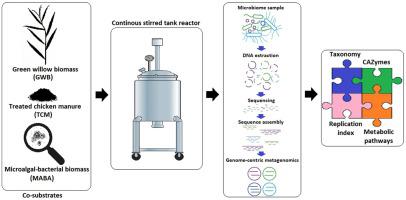Journal of Biotechnology ( IF 4.1 ) Pub Date : 2021-08-08 , DOI: 10.1016/j.jbiotec.2021.08.002 Roland Wirth 1 , Bernadett Pap 2 , Dénes Dudits 2 , Balázs Kakuk 3 , Zoltán Bagi 3 , Prateek Shetty 2 , Kornél L Kovács 4 , Gergely Maróti 5

|
Biogas production through co-digestion of second and third generation substrates is an environmentally sustainable approach. Green willow biomass, chicken manure waste and microalgae biomass substrates were combined in the anaerobic digestion experiments. Biochemical methane potential test showed that biogas yields of co-digestions were significantly higher compared to the yield when energy willow was the sole substrate. To scale up the experiment continuous stirred-tank reactors (CSRTs) are employed, digestion parameters are monitored. Furthermore, genome-centric metagenomics approach was employed to gain functional insight into the complex anaerobic decomposing process. This revealed the importance of Firmicutes, Actinobacteria, Proteobacteria and Bacteroidetes phyla as major bacterial participants, while Methanomicrobia and Methanobacteria represented the archaeal constituents of the communities. The bacterial phyla were shown to perform the carbohydrate hydrolysis. Among the representatives of long-chain carbohydrate hydrolysing microbes Bin_61: Clostridia is newly identified metagenome assembled genome (MAG) and Bin_13: DTU010 sp900018335 is common and abundant in all CSTRs. Methanogenesis was linked to the slow-growing members of the community, where hydrogenotrophic methanogen species Methanoculleus (Bin_10) and Methanobacterium (Bin_4) predominate. A sensitive balance between H2 producers and consumers was shown to be critical for stable biomethane production and efficient waste biodegradation.
中文翻译:

使用可持续的第二和第三代底物进行以基因组为中心的厌氧消化研究
通过共同消化第二代和第三代底物生产沼气是一种环境可持续的方法。在厌氧消化实验中结合了绿柳生物质、鸡粪废物和微藻生物质底物。生化甲烷潜力测试表明,与能量柳为唯一基质时的产量相比,共消化的沼气产量显着更高。为了扩大实验规模,采用连续搅拌釜反应器 (CSRT),监测消化参数。此外,以基因组为中心的宏基因组学方法被用来获得对复杂厌氧分解过程的功能洞察。这揭示了厚壁菌门、放线菌门、变形菌门和拟杆菌门作为主要细菌参与者的重要性,而甲烷微生物和甲烷细菌代表了社区的古菌成分。显示细菌门进行碳水化合物水解。长链碳水化合物水解微生物代表中的Bin_61:梭状芽孢杆菌是新发现的宏基因组组装基因组(MAG)和Bin_13:DTU010 sp900018335在所有 CSTR 中都很常见且含量丰富。产甲烷与群落中生长缓慢的成员有关,其中氢营养型产甲烷菌物种Methanoculleus (Bin_10) 和Methanobacterium (Bin_4) 占主导地位。H 2生产者和消费者之间的敏感平衡被证明对于稳定的生物甲烷生产和有效的废物生物降解至关重要。











































 京公网安备 11010802027423号
京公网安备 11010802027423号